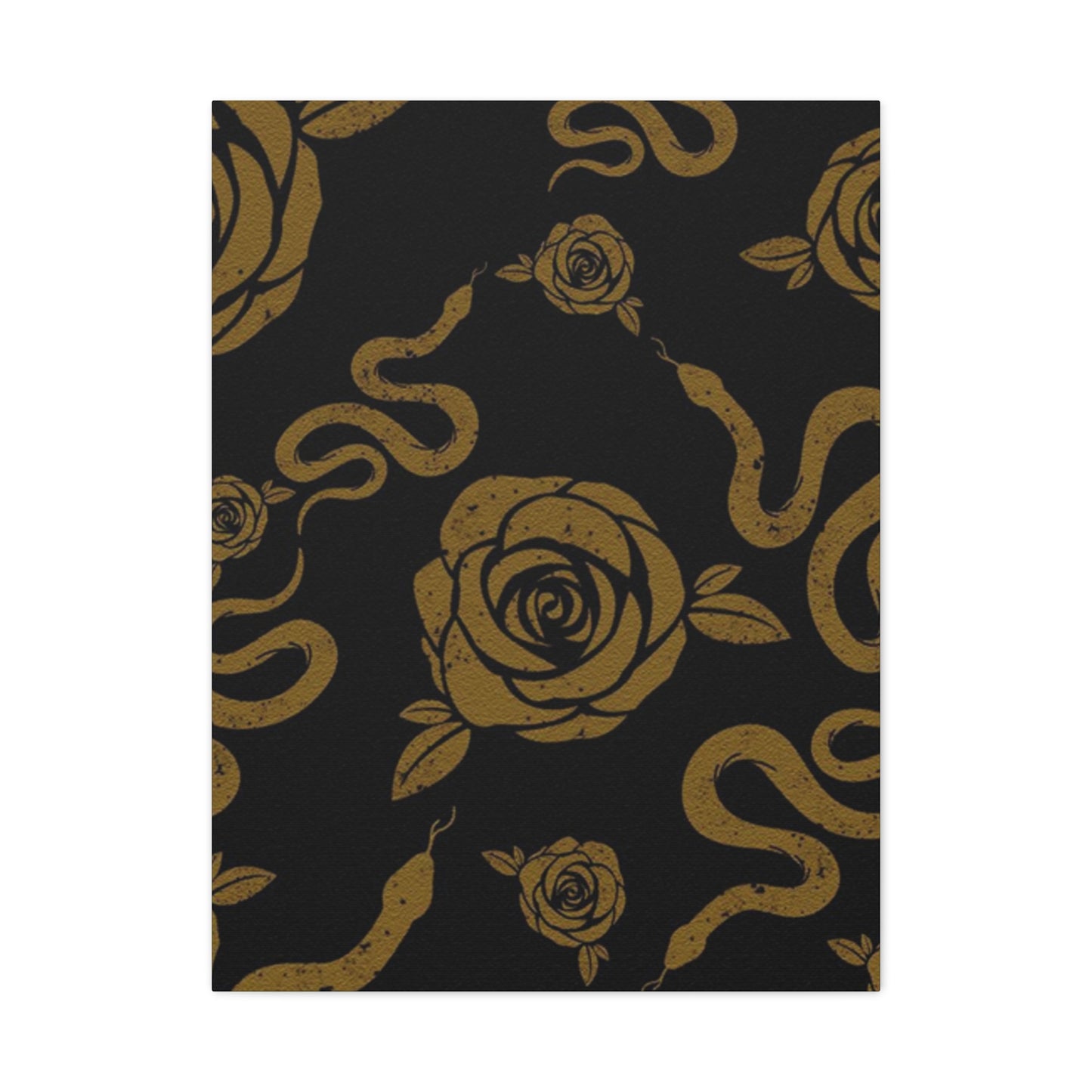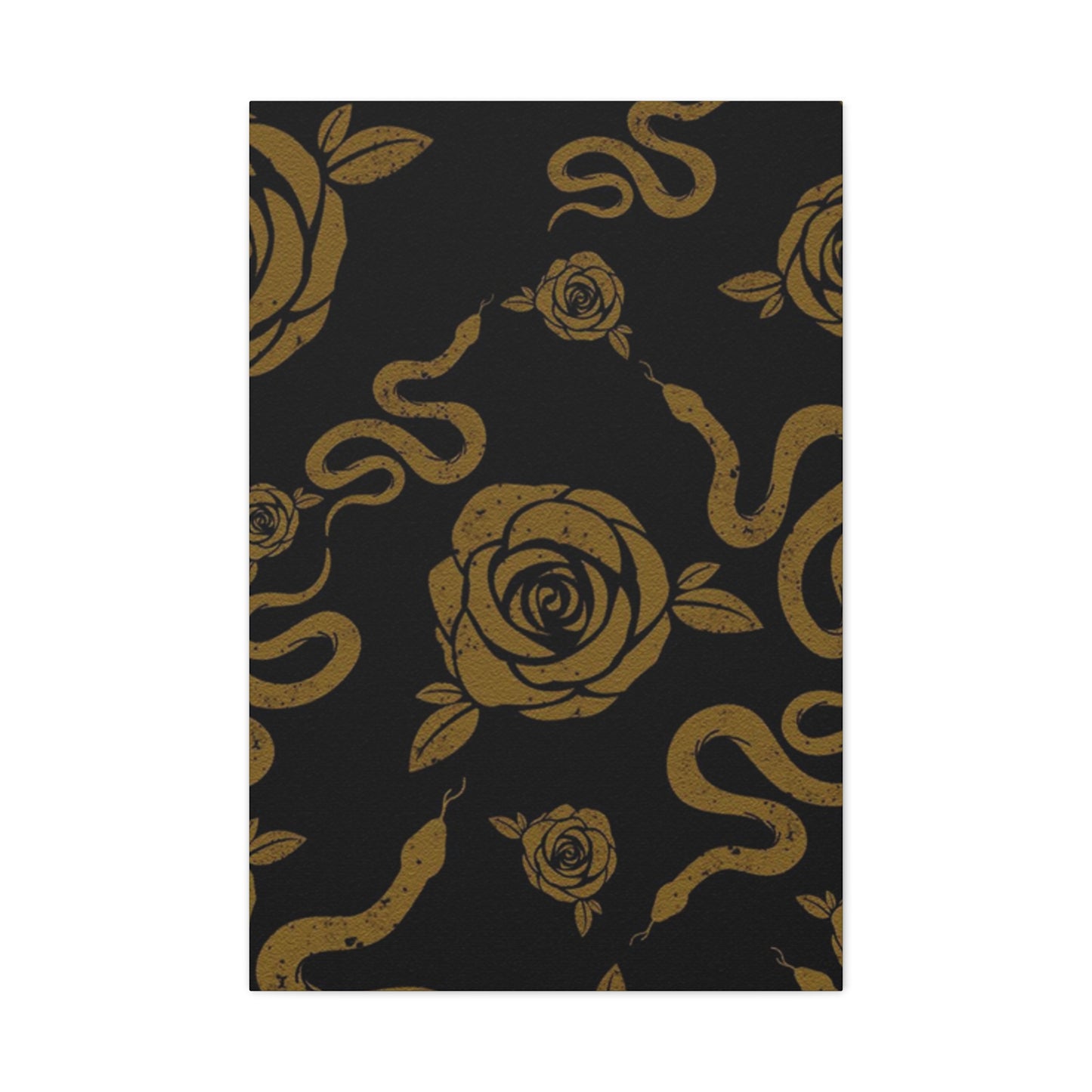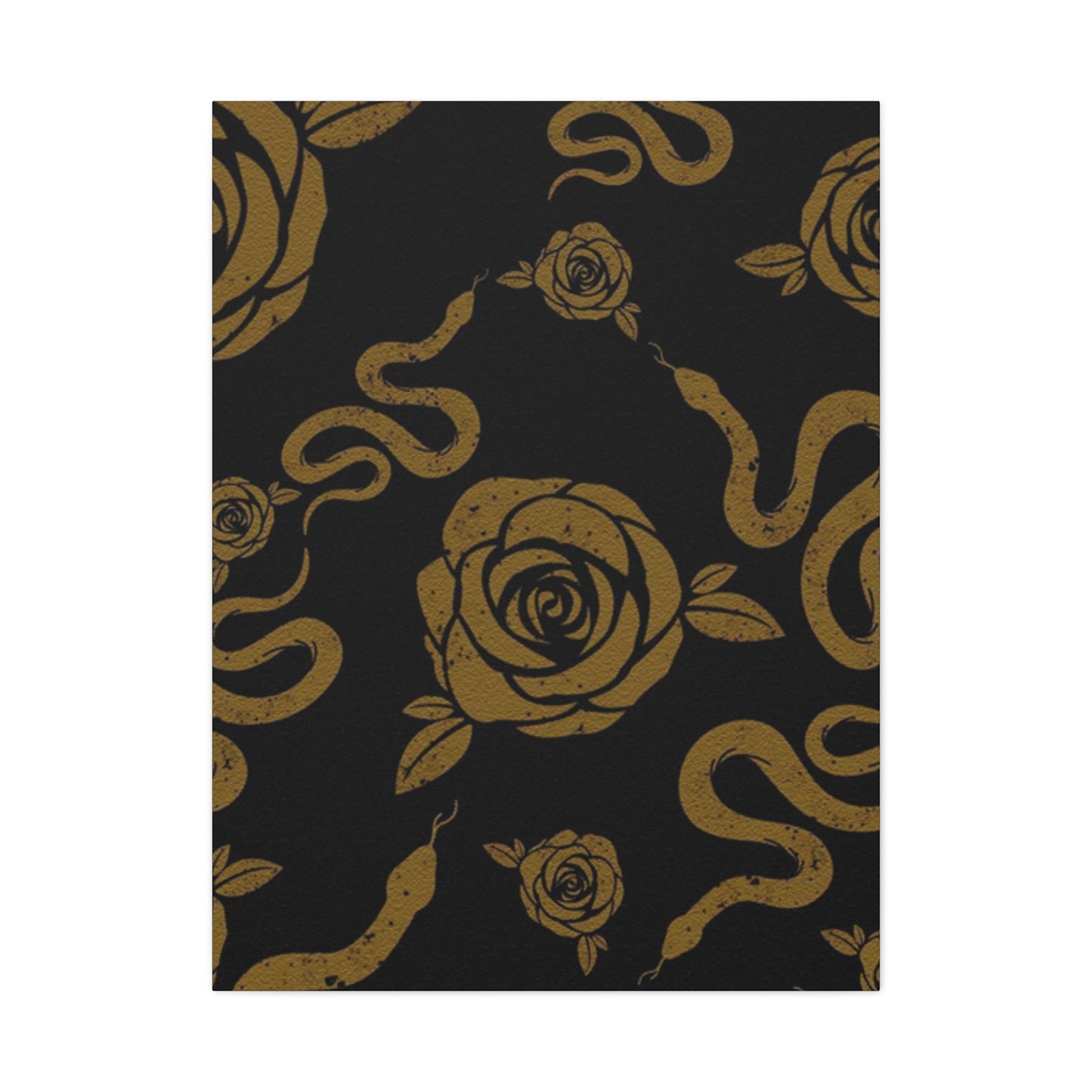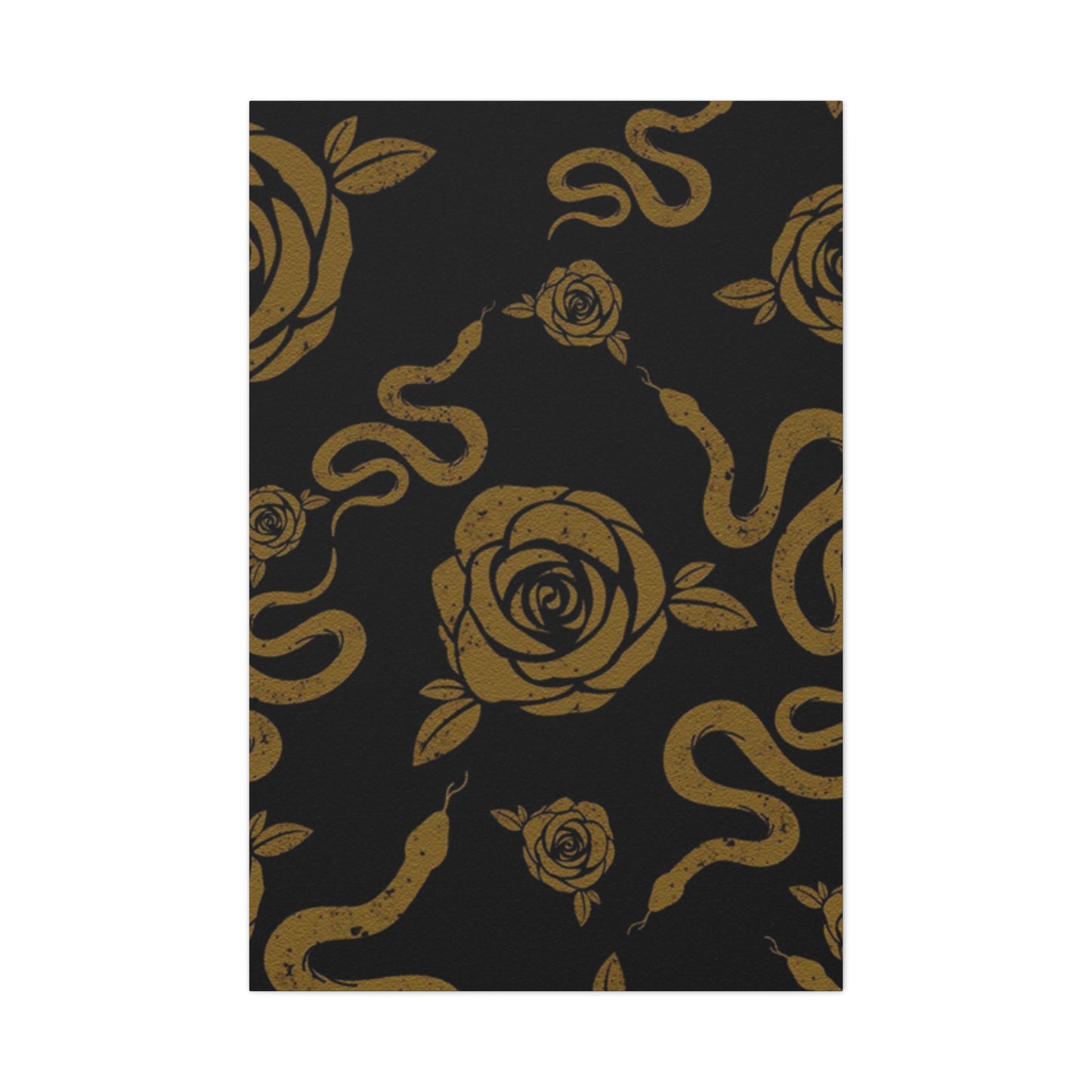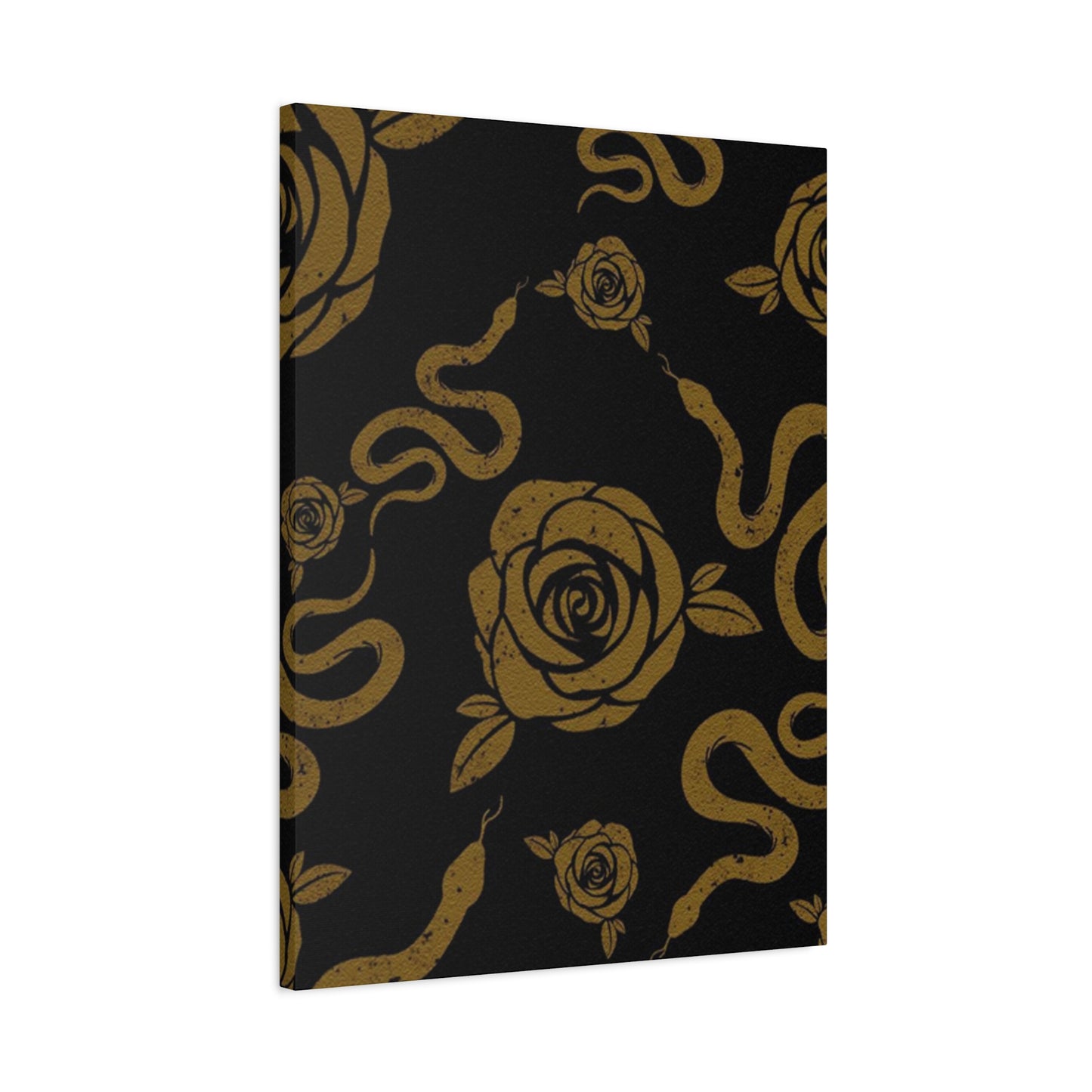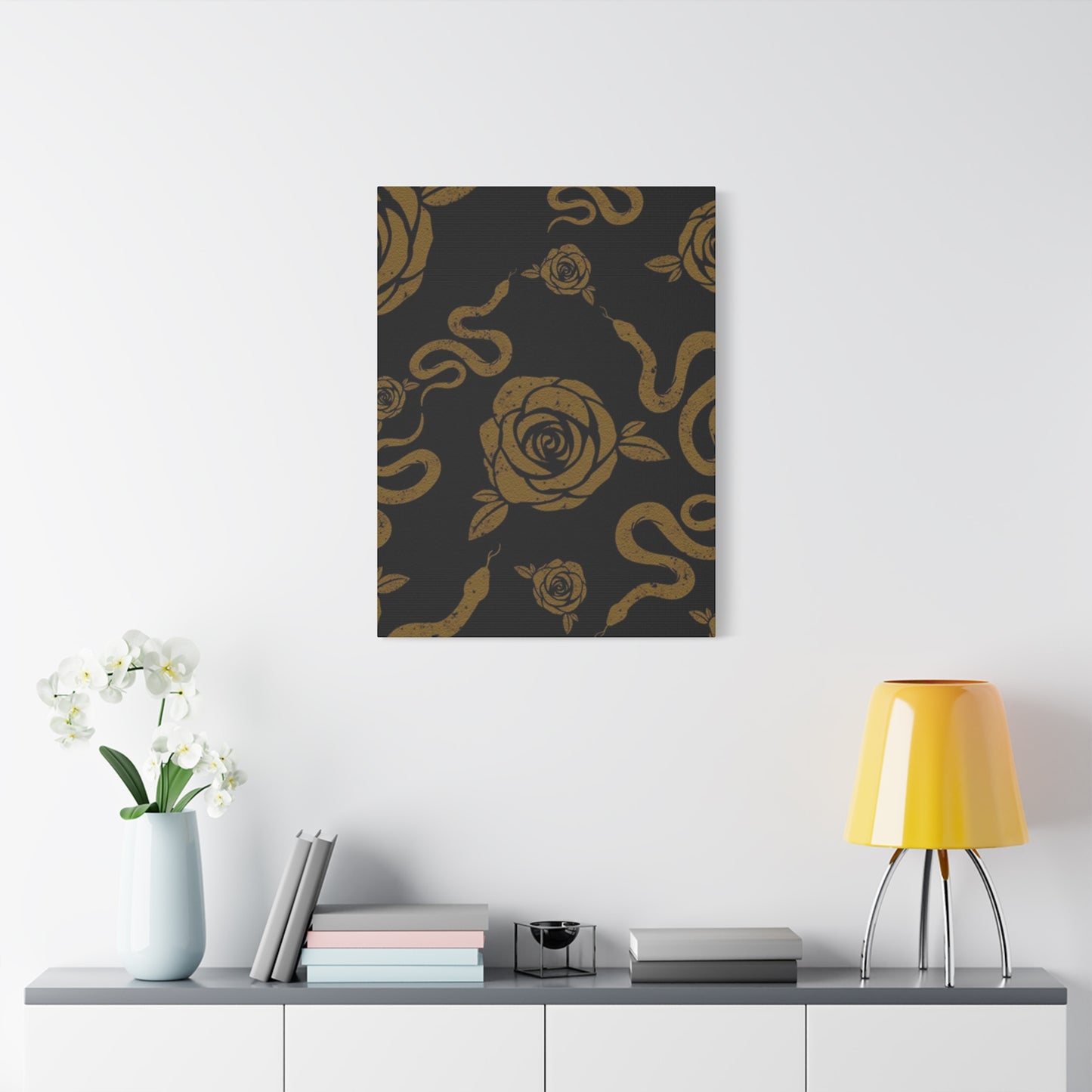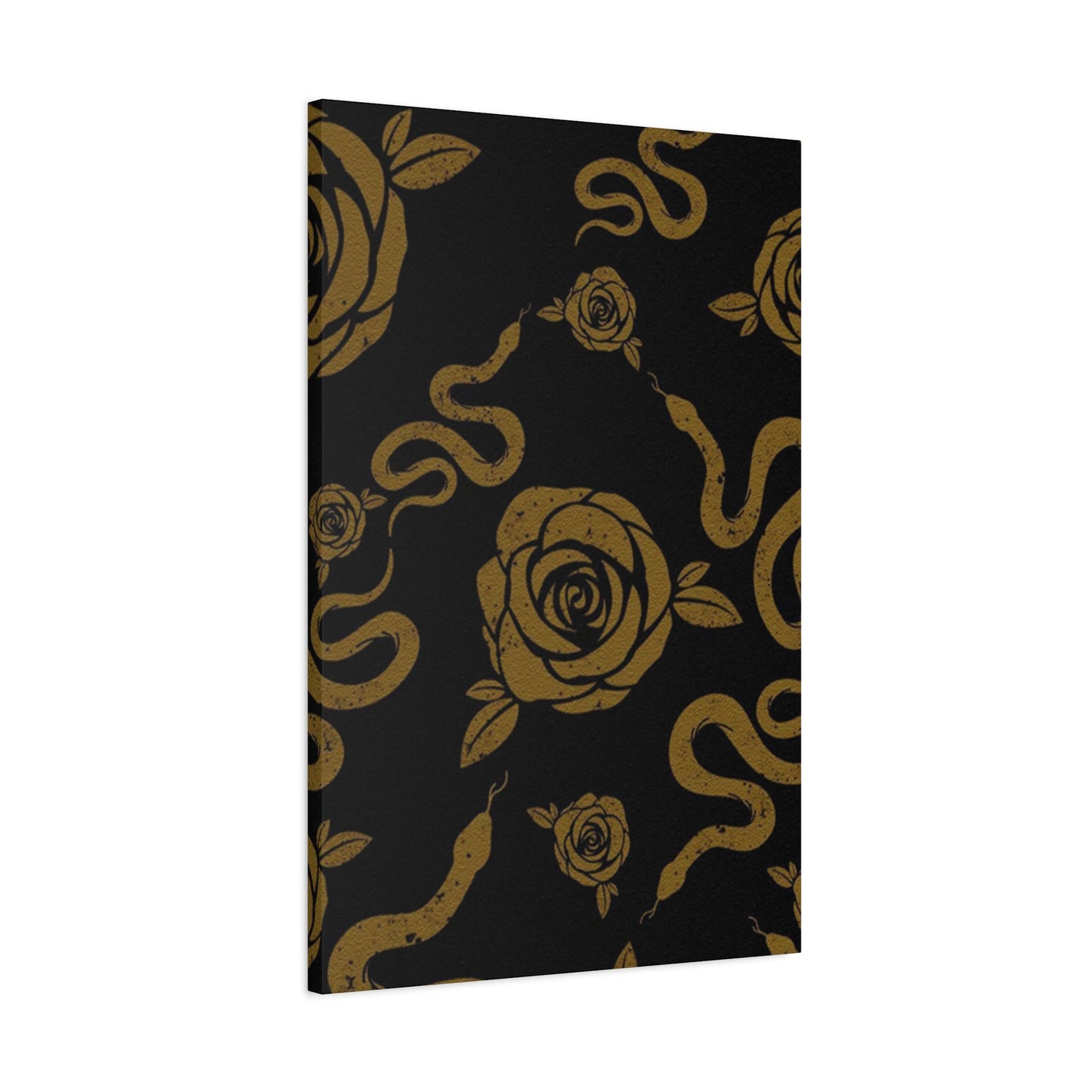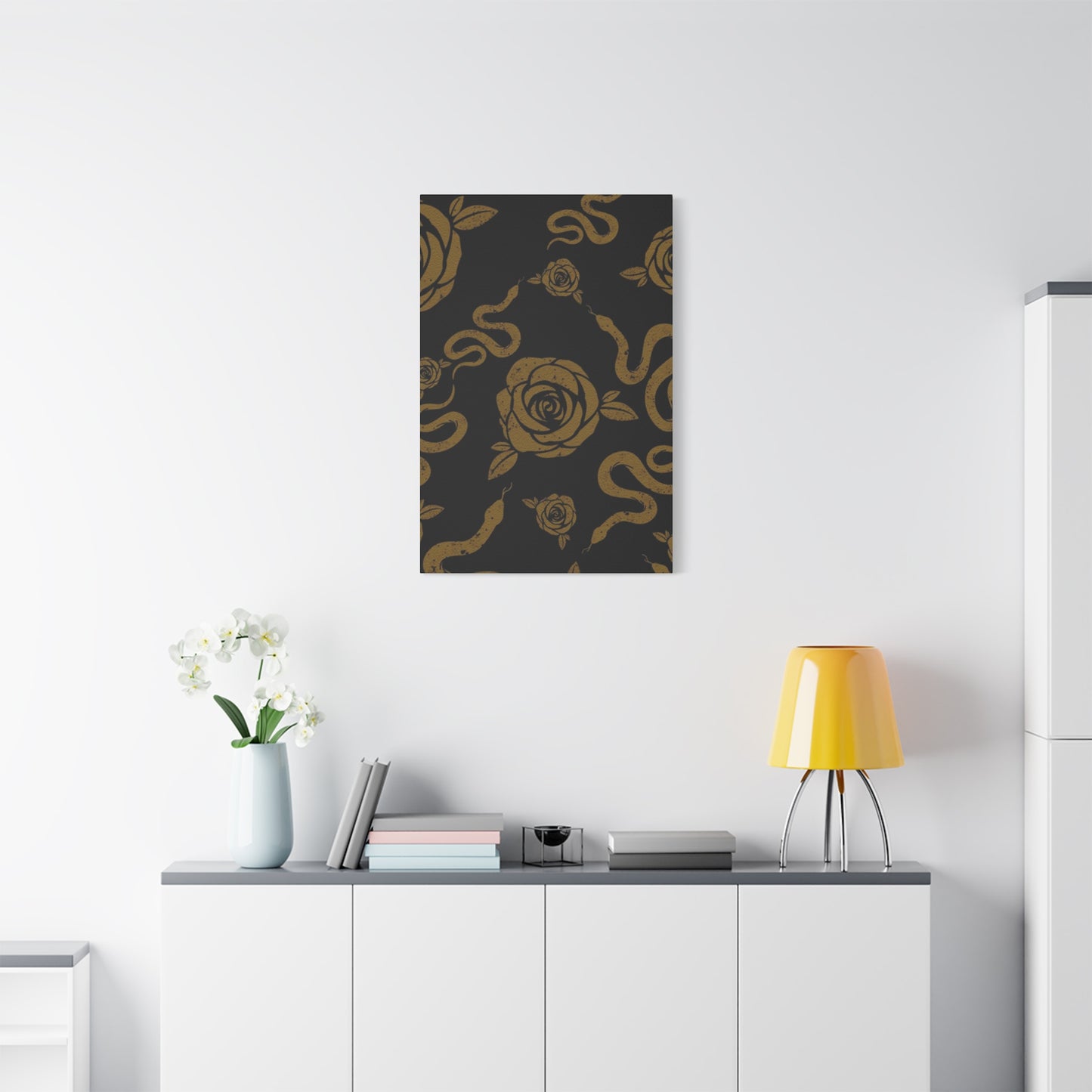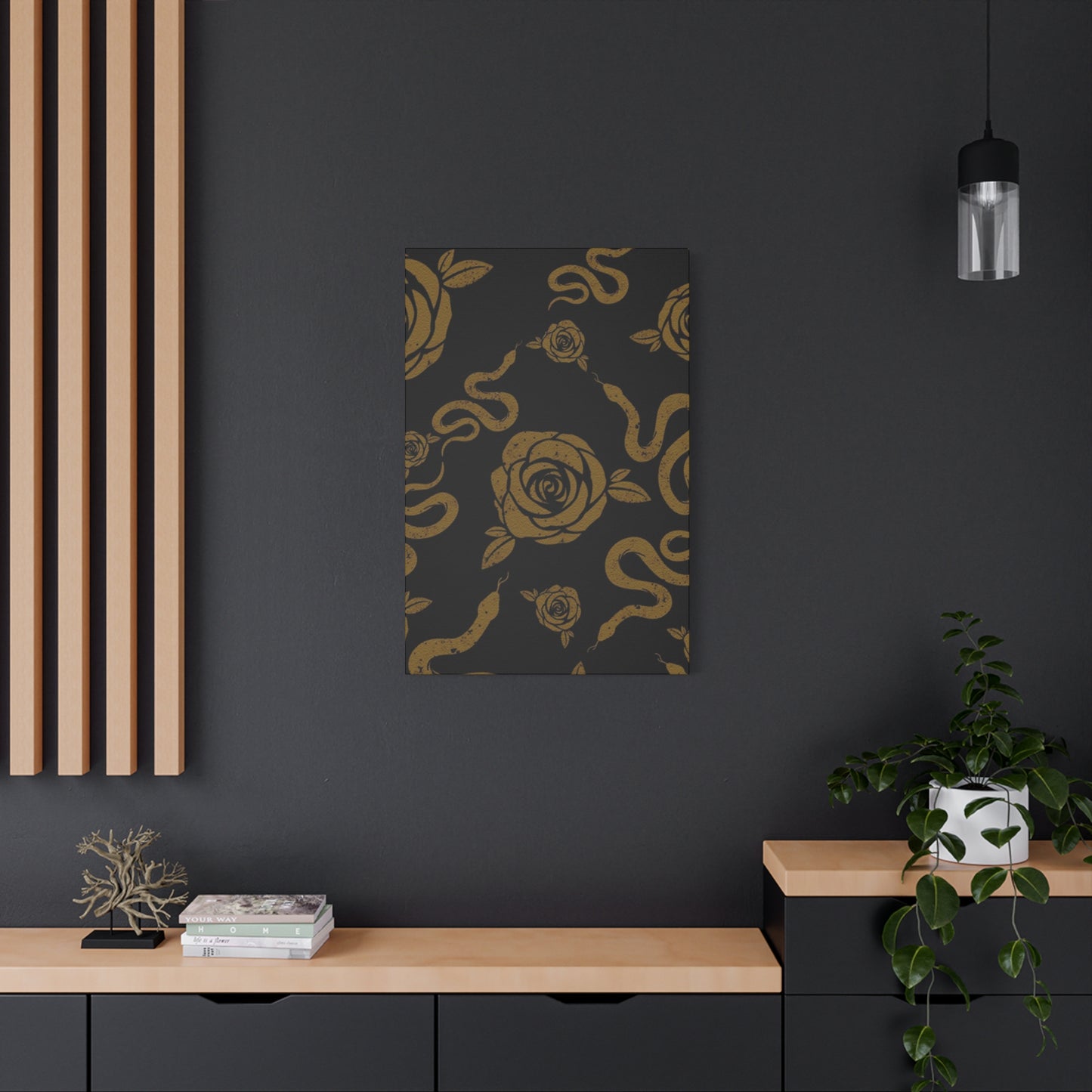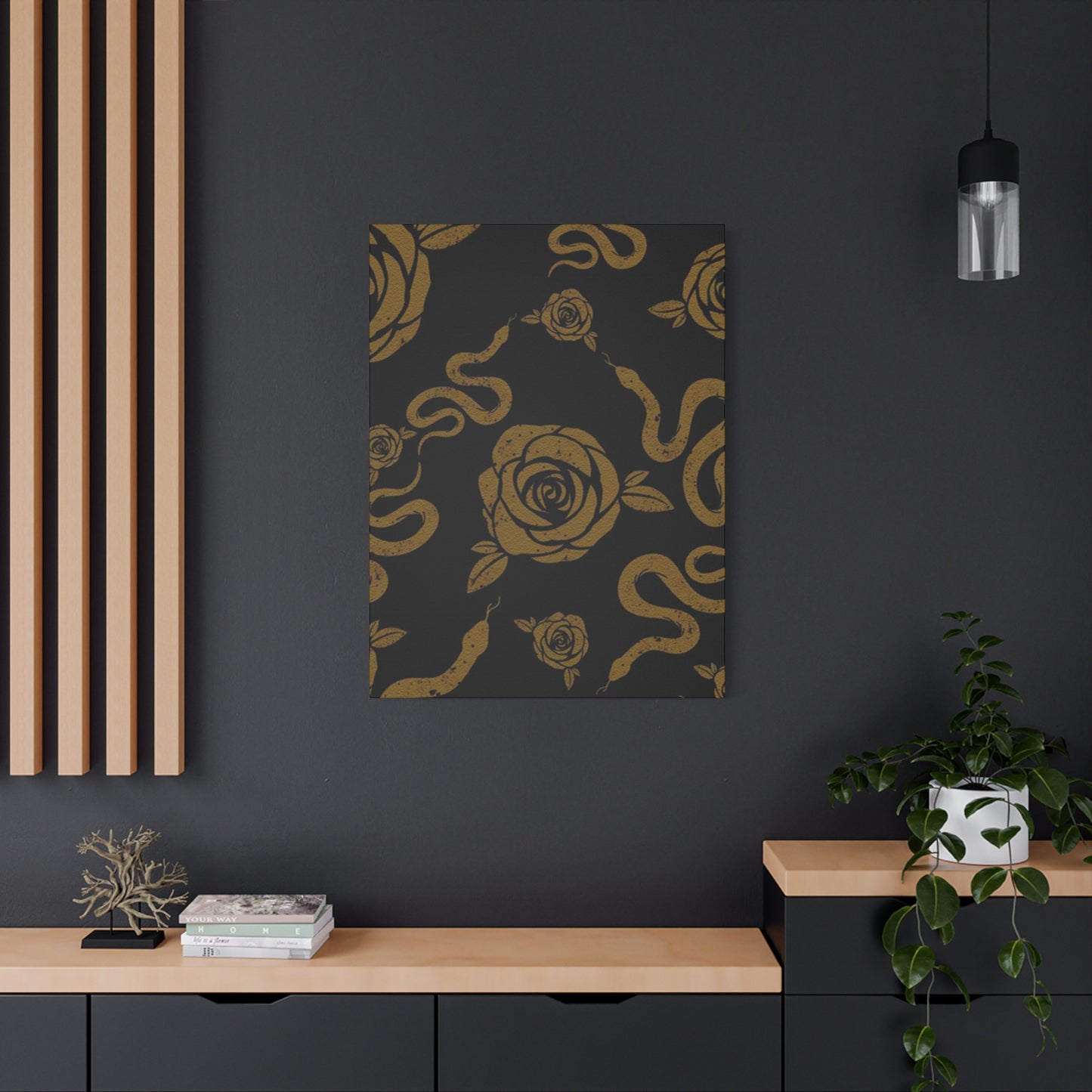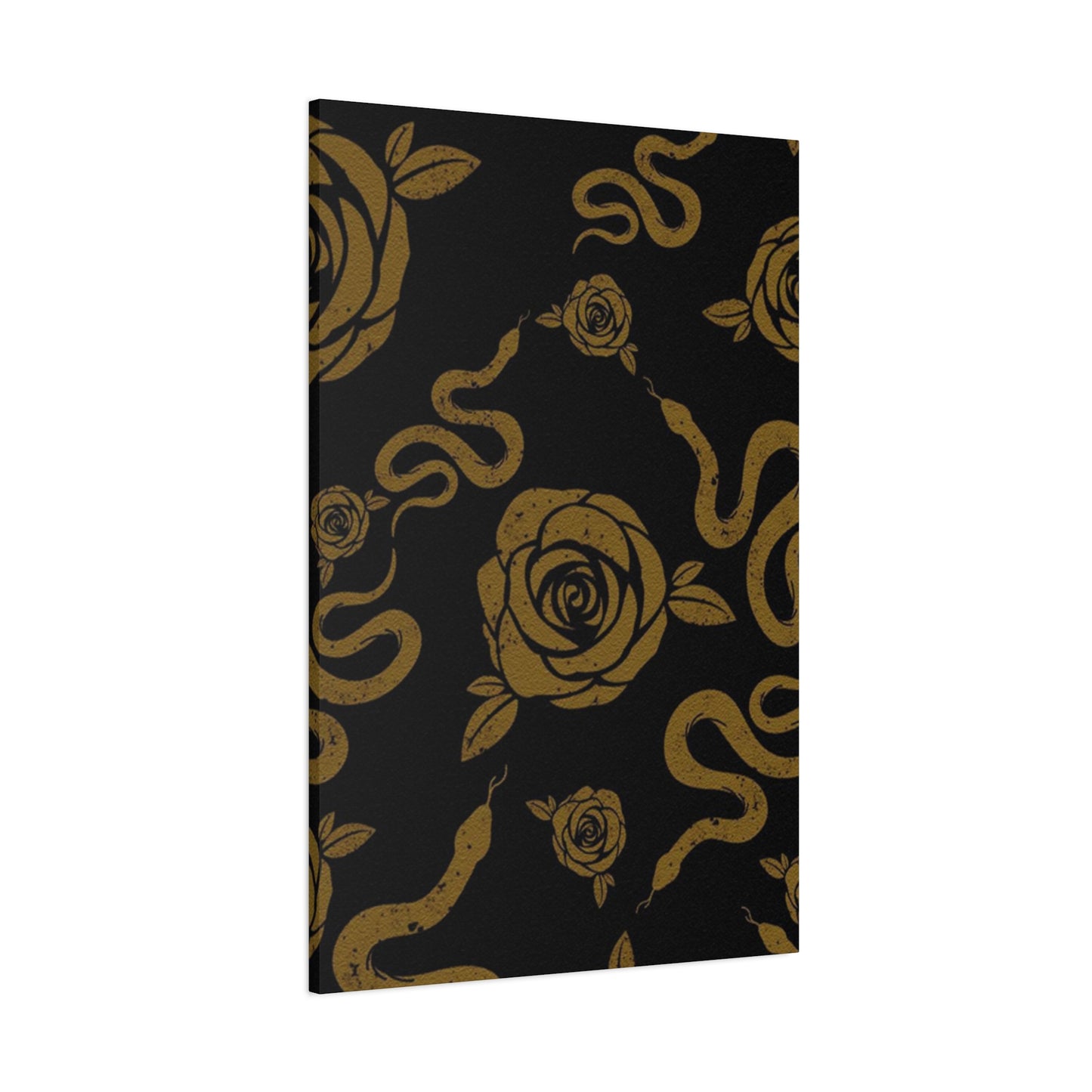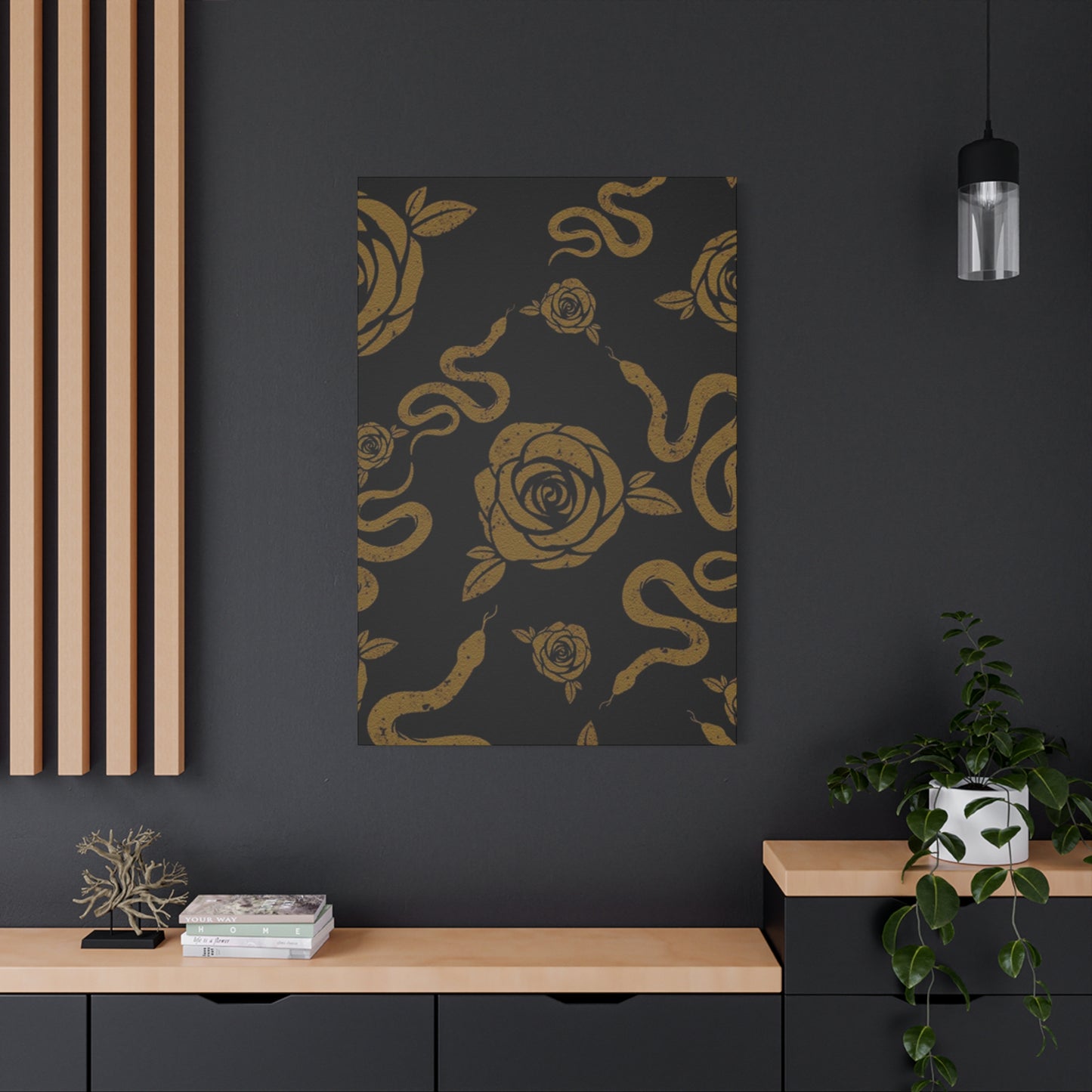Snake and Rose Wall Art Canvas Prints: A Complete Guide to Stunning Botanical and Reptilian Home Decor
The combination of serpents and blooming flowers creates one of the most captivating and symbolically rich visual themes in contemporary interior design. This artistic pairing brings together contrasting elements that speak to transformation, beauty, danger, and renewal. When these powerful symbols merge on canvas prints designed for wall display, they create conversation pieces that elevate any living space with depth and character.
Home decorators and art enthusiasts increasingly seek pieces that tell stories and carry meaningful symbolism. The merging of botanical elements with reptilian imagery satisfies this desire while offering stunning visual appeal. These artistic representations work beautifully in various interior design styles, from modern minimalist spaces to bohemian sanctuaries and everything in between.
The rising popularity of this artistic theme reflects a broader cultural appreciation for nature-inspired designs that carry layered meanings. Whether displayed in bedrooms, living rooms, studios, or offices, these canvas prints become focal points that draw the eye and spark conversation. Understanding the various aspects of selecting, displaying, and appreciating these artworks helps homeowners make informed decisions that enhance their living environments.
This comprehensive exploration covers everything from the symbolic significance behind these images to practical considerations for purchase and placement. By examining the artistic traditions, psychological impact, design variations, and decorative applications, you'll gain the knowledge needed to incorporate these striking pieces into your home successfully.
The Deep Symbolism Behind Serpent and Floral Imagery
The combination of serpentine forms with botanical elements carries profound symbolic weight across numerous cultures and historical periods. This pairing represents the eternal dance between danger and beauty, death and rebirth, knowledge and innocence. Ancient civilizations recognized the powerful metaphorical potential of both serpents and flowers, often depicting them in religious art, mythology, and ceremonial objects.
Serpents have symbolized transformation throughout human history due to their ability to shed their skin, representing renewal and the cyclical nature of existence. In many spiritual traditions, they embody wisdom, healing, and the kundalini energy that rises through the body's energy centers. The serpent's dual nature as both protective and dangerous makes it a complex symbol that invites contemplation and respect.
Flowers, particularly roses, carry their own rich symbolic heritage. The rose traditionally represents love, passion, beauty, and the fleeting nature of life. Its thorns remind viewers that beauty often comes with protection mechanisms, and that worthwhile pursuits may involve risk or discomfort. The layers of rose petals symbolize the unfolding of consciousness and the revelation of hidden truths.
When these two powerful symbols combine in visual art, they create a dialogue about the complexity of existence. The artwork suggests that beauty and danger coexist, that growth requires shedding old patterns, and that life's most profound experiences often involve navigating between opposing forces. This philosophical depth gives the imagery lasting appeal that transcends temporary design trends.
The specific arrangement of serpents and flowers within compositions affects their symbolic interpretation. A serpent winding through roses might suggest temptation in paradise, echoing ancient stories of forbidden knowledge. A serpent protecting or embracing flowers could represent the guardian aspect of nature's more fearsome elements. Understanding these nuances helps viewers select pieces that resonate with their personal philosophy.
Different cultural perspectives add additional layers of meaning to this imagery. Eastern traditions might interpret the serpent as representing vital life force energy, while Western viewers might connect it to transformation and healing through the caduceus symbol. These multiple interpretive possibilities make the artwork universally appealing while allowing for personal connection based on individual cultural background and beliefs.
The color palette chosen for these compositions significantly influences their symbolic message. Dark, moody tones suggest mystery and the shadow aspects of nature, while vibrant colors emphasize vitality and celebration of life. Metallic accents might add spiritual or alchemical dimensions, suggesting transformation of base materials into precious ones. This visual flexibility allows the theme to adapt to various decorative contexts while maintaining symbolic integrity.
Design Variations and Artistic Styles Available
Contemporary artists and designers create serpent and flower canvas prints in an impressive range of styles to suit diverse aesthetic preferences. Realistic, naturalistic renderings appeal to those who appreciate scientific illustration and want artwork that accurately depicts botanical and zoological subjects. These pieces often feature meticulous detail, showing individual scales, petal textures, and subtle color variations found in nature.
Illustrative styles with bold outlines and simplified forms draw inspiration from tattoo art and graphic design traditions. These compositions emphasize shape and composition over realistic detail, creating striking visual impact from a distance. The clear delineation between elements makes these pieces particularly effective in busy spaces where more subtle artwork might get visually lost.
Watercolor-inspired prints offer soft, ethereal interpretations of the theme with blended colors and organic edges. This approach creates dreamy, romantic atmospheres and works beautifully in spaces designed for relaxation and reflection. The transparency effects characteristic of watercolor techniques add layers of depth as colors overlap and interact.
Abstract and geometric interpretations deconstruct serpent and flower forms into patterns, shapes, and color relationships. These modernist approaches appeal to those who prefer contemporary design aesthetics and want the thematic elements suggested rather than literally depicted. Such pieces provide the symbolic resonance of the subject matter without dominating spaces with representational imagery.
Gothic and dark romantic styles present the theme with dramatic contrast, deep shadows, and moody color palettes. These interpretations emphasize the mysterious and dangerous aspects of serpents while presenting flowers at various stages of bloom and decay. This aesthetic works particularly well in spaces with industrial, vintage, or maximalist design schemes.
Minimalist line drawings reduce the subjects to their essential forms, creating sophisticated pieces that work in spaces requiring visual restraint. These single-line or limited-stroke compositions demonstrate artistic skill while maintaining the clean, uncluttered aesthetic valued in contemporary minimalist interiors. Despite their simplicity, these pieces retain the symbolic power of their subjects.
Psychedelic and surrealistic interpretations transform serpents and flowers into otherworldly visions with unexpected color combinations, impossible perspectives, and dreamlike atmospheres. These pieces appeal to those drawn to visionary art, consciousness exploration, and unconventional beauty. The bold creativity of these interpretations makes them conversation starters and artistic focal points.
Color Palette Selection for Different Interior Design Schemes
The color scheme of serpent and flower artwork dramatically affects how it integrates with existing interior design. Monochromatic compositions in blacks, whites, and grays offer sophisticated neutrality that complements virtually any color scheme. These pieces provide visual interest through composition and contrast rather than color, making them versatile choices for spaces where wall art needs to coordinate with changing decor elements.
Jewel-tone palettes featuring deep emeralds, sapphires, rubies, and amethysts create luxurious, opulent atmospheres. These rich colors work beautifully in spaces with gold or brass fixtures, velvet upholstery, and other elements that convey elegance and refinement. The depth of jewel tones adds warmth without the sweetness of pastels or the intensity of primary colors.
Earth-tone compositions in browns, tans, olives, and rusty oranges harmonize with natural materials like wood, stone, and leather. These organic color schemes support biophilic design principles and create grounded, stable atmospheres. Serpent and flower imagery in earth tones feels particularly cohesive, as both subjects exist in nature's color range.
Pastel interpretations with soft pinks, lavenders, mint greens, and pale yellows create gentle, romantic atmospheres suitable for bedrooms, nurseries, and spaces designed for relaxation. These lighter values keep spaces feeling open and airy while still providing artistic interest. The softness of pastels makes even the serpent element feel approachable and decorative rather than threatening.
Bold primary and secondary color schemes create energetic, modern aesthetics that work in contemporary and eclectic spaces. Bright reds against electric blues, or vivid purples with chartreuse greens make strong statements and serve as artistic focal points. These high-contrast combinations suit personalities that embrace boldness and aren't afraid of visual impact.
Metallic accents in gold, silver, copper, or rose gold add luxurious dimension to serpent and flower compositions. These reflective elements catch light differently throughout the day, creating subtle movement and changing appearances. Metallic details work particularly well in styles that reference art deco, glamorous Hollywood regency, or contemporary luxury aesthetics.
Gradients and ombre effects that transition from one color family to another create dynamic visual movement within individual pieces. A composition might shift from deep purple at the bottom to soft pink at the top, with the serpent and flowers distributed throughout the color transition. These pieces work beautifully as statement pieces in spaces with otherwise minimal color variation.
Selecting the Appropriate Canvas Size for Your Space
Determining the correct canvas size involves considering both the wall dimensions and the room's overall proportions. A common mistake involves choosing artwork that's too small for the available space, resulting in pieces that look lost on expansive walls. As a general guideline, artwork should occupy roughly two-thirds to three-quarters of the furniture width it hangs above, creating visual balance.
Large-scale canvas prints measuring four feet or larger in either dimension create dramatic focal points suitable for living rooms, dining areas, and master bedrooms. These substantial pieces command attention and can anchor an entire room's design scheme. The impressive size allows for appreciating fine details while also reading clearly from across the room.
Medium-sized canvases ranging from two to four feet work well in most residential applications, offering flexibility without overwhelming smaller spaces. These proportions suit bedrooms, home offices, hallways, and secondary living areas. Medium pieces also work beautifully in gallery wall arrangements combined with complementary artwork in various sizes.
Small canvas prints under two feet in dimension serve specific purposes in design schemes. They work well in intimate spaces like bathrooms, closets, reading nooks, and narrow hallways. Multiple small canvases can create gallery walls with varied compositions. Small-scale works also allow collectors to acquire pieces by favorite artists without requiring extensive wall space.
Vertical orientations elongate walls and draw the eye upward, making spaces feel taller. These proportions work particularly well for serpent imagery that naturally winds upward through compositions. Vertical canvases suit narrow wall spaces beside windows, doors, or built-in features where horizontal pieces wouldn't fit properly.
Horizontal formats create calm, stable compositions that work above sofas, beds, and console tables. The width emphasizes the landscape format and allows for compositions showing serpents moving across the canvas through floral environments. These proportions complement the horizontal lines of furniture beneath them.
Square formats offer balanced, contained compositions that work in both traditional and contemporary settings. The equal dimensions create harmonious proportions that feel complete and self-contained. Square canvases work beautifully in grid arrangements or as standalone statement pieces that don't favor any particular directional emphasis.
Canvas Print Quality Considerations and Materials
Understanding canvas print production methods helps buyers make informed decisions about quality and longevity. Giclée printing represents the highest quality standard for canvas reproduction, using archival-quality inks and high-resolution digital imaging to create prints virtually indistinguishable from original paintings. This process ensures accurate color reproduction and exceptional detail rendering.
The canvas material itself significantly affects both appearance and durability. Premium cotton canvas offers superior longevity and a traditional texture that resembles artist canvas. Polyester blends cost less but may not age as gracefully. The canvas weight, measured in ounces per square yard, indicates thickness and durability, with heavier weights providing more substantial finished pieces.
Ink quality determines both initial vibrancy and long-term color stability. Pigment-based inks resist fading far better than dye-based alternatives, maintaining their appearance for decades when properly displayed. UV-resistant inks provide additional protection against the sun exposure that causes most artwork deterioration over time.
Stretching methods affect how canvases appear and how easily they can be displayed. Gallery wrap techniques fold the printed image around the frame edges, creating finished sides that don't require additional framing. Museum wrap methods keep the image on the front face only, with neutral-colored sides suitable for traditional framing if desired.
Frame construction quality impacts both appearance and stability. Solid wood stretcher bars provide superior strength and resistance to warping compared to composite alternatives. Proper corner joinery ensures frames maintain their square shape over time. Crossbar supports prevent sagging in larger pieces.
Protective coatings applied to finished canvases shield against dust, moisture, and minor abrasions. These clear layers don't alter the artwork's appearance but significantly extend its functional lifespan. Some coatings also provide additional UV protection, though they should complement rather than replace careful placement away from direct sunlight.
Packaging quality for shipping ensures canvases arrive undamaged. Corner protectors, rigid backing, and adequate cushioning material prevent the crushing, creasing, and puncturing that can occur during transit. Reputable sellers invest in proper packaging that reflects their commitment to delivering products in perfect condition.
Complementary Decor Elements and Design Coordination
Successfully integrating serpent and flower canvas prints into existing spaces involves considering complementary design elements that enhance rather than compete with the artwork. Furniture selection provides opportunities to echo colors, shapes, or themes present in the canvas. A velvet sofa in a jewel tone that appears in the artwork creates cohesion, while metallic accent tables might reflect golden highlights in the print.
Textile choices including throw pillows, blankets, and curtains offer additional coordination opportunities. Selecting fabrics that incorporate botanical prints, organic textures, or colors from the canvas creates layers of visual connection throughout the space. However, these supporting elements should be more subdued than the main artwork to avoid overwhelming the senses.
Lighting design dramatically affects how canvas prints appear and the atmosphere they create. Picture lights mounted above canvases highlight artwork while creating gallery-like presentation. Ambient lighting schemes using dimmers allow residents to adjust the mood from bright and energizing to soft and intimate. Natural light considerations include protecting artwork from direct sun while utilizing daylight to reveal colors accurately.
Plant selections in rooms featuring botanical artwork create living connections between art and nature. Choosing plants with similar characteristics to those depicted strengthens thematic coherence. However, real plants should complement rather than compete with the artwork, typically occupying different visual zones within the space.
Decorative accessories provide opportunities for subtle thematic reinforcement. Ceramic vessels with serpentine shapes, books about botanical illustration or reptile conservation, or candles in floral scents create layered storytelling within the space. These elements should be carefully curated to avoid heavy-handed matching that feels contrived rather than collected.
Architectural elements including molding, built-ins, and structural features affect artwork display. Drawing attention to or downplaying these elements through paint choices influences how prominently the canvas reads within the space. In rooms with ornate architectural detail, simpler artwork prevents visual chaos, while minimalist spaces can handle more complex, detailed prints.
Floor and wall treatments create the foundation upon which all design elements rest. Neutral wall colors allow colorful artwork to command attention, while accent walls can either frame or compete with canvas prints depending on color and finish choices. Flooring materials from hardwood to tile to carpet affect the overall ambiance and should factor into cohesive design planning.
Installation Methods and Wall Mounting Techniques
Proper installation ensures canvas prints hang securely and appear level and professional. The most common hanging method uses D-rings or sawtooth hangers attached to the wooden stretcher frame, with corresponding wall hooks supporting the weight. This simple approach works well for lightweight to medium-weight canvases and allows for minor adjustments after hanging.
Heavy-duty canvases require more substantial mounting solutions. French cleats provide exceptional security for large pieces, distributing weight along the entire top edge rather than concentrating stress at two points. This professional method creates flush wall mounting that appears seamless. Installation requires accurate measurement and level mounting of both wall and canvas components.
Wire hanging systems offer adjustment flexibility, allowing pieces to slide along the wire to find the perfect position. This method works particularly well in gallery wall arrangements where precise spacing between multiple pieces matters. The wire should be strong enough to support the canvas weight with safety margin, and wall hooks must be rated for the appropriate load.
Adhesive hanging strips provide damage-free mounting solutions for renters or those who prefer avoiding wall holes. Modern adhesive technology creates surprisingly strong bonds that support substantial weights. This method requires careful application to clean surfaces and works best with lightweight to medium-weight canvases. Following manufacturer instructions ensures maximum holding power.
Traditional picture rail systems popular in older homes offer elegant solutions that preserve wall surfaces. Canvases hang from hooks that slide along rails mounted near the ceiling, with adjustable cords or wires determining the hanging height. This method allows for easy rearrangement without creating new wall holes. The visible hanging system becomes part of the gallery aesthetic.
Stud mounting provides the most secure installation for valuable or heavy pieces. Locating wall studs with electronic finders allows screws to anchor into solid wood framing rather than just drywall. This method distributes weight to structural elements and provides confidence that expensive artwork won't unexpectedly crash down.
Measuring and leveling tools ensure professional-looking installations. Laser levels project perfectly horizontal lines for aligning artwork, while measuring tapes confirm proper spacing in multi-piece arrangements. Creating paper templates matching the canvas dimensions allows for previewing arrangements before committing to wall holes. Taking time with these preparatory steps prevents frustrating adjustments and unnecessary wall damage.
Creating Gallery Walls with Multiple Canvas Prints
Gallery walls transform single artworks into curated collections that make bold design statements. Successfully arranging multiple serpent and flower canvases requires balancing unity and variety. Pieces should share enough visual characteristics to feel intentionally grouped while offering sufficient diversity to maintain interest. Color palette consistency often provides the unifying factor while allowing varied compositions and sizes.
Symmetrical gallery walls create formal, balanced arrangements with orderly spacing and alignment. This approach works well in traditional spaces and creates calm, organized visual impact. The largest canvas typically occupies the center position, with progressively smaller pieces arranged in balanced positions around it. Careful measurement ensures even spacing that reads as intentional rather than haphazard.
Asymmetrical arrangements feel more casual and contemporary, allowing for organic groupings that seem to have evolved over time. This approach accommodates varied canvas sizes and orientations more easily than rigid grids. The key to successful asymmetry involves maintaining visual weight balance, ensuring one area doesn't feel significantly heavier than others.
Grid layouts with consistent spacing create modern, graphic impact. Canvases of identical size arranged in perfect rows and columns create rhythm through repetition. This approach works particularly well with a series of related images, such as different serpent and flower compositions in a unified style. The regimented spacing creates order even when individual images vary.
Salon-style arrangements mimic traditional European galleries with artworks covering entire walls from floor to ceiling. This maximalist approach works beautifully for collectors wanting to display extensive collections. The eclectic mix of sizes and orientations creates visual richness, though the pieces should maintain some unifying characteristics to avoid chaotic appearance.
Template mapping involves creating full-scale paper patterns of each canvas and arranging them on the wall with removable tape before installing the actual artwork. This trial-and-error approach allows experimentation without creating unnecessary wall holes. Once the arrangement looks balanced, marks indicate where hardware should be installed. This extra step significantly improves final results.
Spacing considerations affect overall impact. Generally, two to six inches between canvases creates distinct individual pieces while maintaining group cohesion. Closer spacing merges pieces into a more unified composition, while wider gaps create breathing room and emphasize each work's independence. Consistent spacing within an arrangement typically looks more professional than varied gaps.
Seasonal and Temporary Display Strategies
While canvas prints serve as permanent design elements, rotating artwork seasonally refreshes spaces without requiring complete redecorating. Creating a collection of serpent and flower pieces in varied color palettes allows swapping based on seasonal moods. Darker, moodier compositions might suit autumn and winter months, while lighter, more vibrant pieces welcome spring and summer energy.
Temporary display methods provide flexibility for those who enjoy frequent changes or want to experiment before committing to permanent installation. Lean-against-wall styling works beautifully for large canvases placed on console tables, mantels, or floors against walls. This casual approach creates effortless, collected aesthetics popular in contemporary interiors. The ability to easily move pieces accommodates evolving preferences.
Easel presentation offers another damage-free display option that adds dimensional interest. Floor easels work for large canvases and create artistic studio atmosphics, while tabletop versions suit smaller pieces. This method works particularly well in creative spaces like home studios or eclectic living areas where the easel itself contributes to the overall aesthetic.
Ledge shelves specifically designed for displaying artwork allow for layering multiple pieces and easy rotation. Canvases simply rest on shallow shelves with lips that prevent sliding. This approach accommodates frequent changes without tools or wall damage. The ability to overlap pieces creates depth and allows more artwork display in limited space.
Hook and loop fastener systems create temporary but secure mounting that removes cleanly. This approach works well for renters or those who frequently redecorate. The industrial-strength fasteners support surprising weight while releasing without surface damage. Following proper application procedures ensures maximum effectiveness and clean removal.
Seasonal decorating integration incorporates canvas art into broader holiday and seasonal styling. During autumn, grouping serpent and flower prints with harvest elements like pumpkins and wheat creates layered displays. Winter holidays might see the same artwork surrounded by evergreen branches and candles. This approach maximizes existing art investments while allowing seasonal creativity.
Exhibition rotation for serious collectors involves carefully storing pieces not currently displayed while showcasing others. Climate-controlled storage protects canvas integrity during dormant periods. Digital cataloging systems help track collections and plan future displays. This curatorial approach transforms homes into personal galleries with evolving exhibitions.
Caring for and Maintaining Canvas Wall Art
Proper maintenance preserves canvas print beauty and extends their functional lifespan significantly. Regular dusting prevents particle accumulation that dulls colors and embeds in canvas texture. Soft, dry microfiber cloths or specialized art dusters gently remove surface dust without scratching protective coatings. Dusting should occur monthly or whenever visible accumulation appears.
Avoiding direct sunlight prevents the fading that represents the primary threat to canvas longevity. UV rays break down inks over time, causing colors to shift and fade. Positioning canvases away from windows or installing UV-filtering window treatments protects against this damage. If sunny wall space offers the only suitable location, UV-resistant protective sprays provide additional defense.
Humidity control maintains canvas and frame integrity. Excessive moisture can cause canvas sagging, frame warping, and in severe cases, mold growth. Conversely, extremely dry conditions make canvas brittle. Maintaining moderate humidity levels between 40-50% through humidifiers or dehumidifiers depending on climate creates ideal preservation conditions.
Temperature stability prevents expansion and contraction that stresses canvas and frame materials. Avoid hanging valuable pieces above heat sources like radiators or fireplaces, or in locations with significant temperature fluctuations. Consistent temperatures between 65-75 degrees Fahrenheit provide optimal conditions.
Handling during cleaning or relocation requires care to prevent accidental damage. Always grasp frames rather than touching canvas surfaces. Face-to-face stacking should be avoided; if pieces must be stacked, place protective material between them and stack like sizes together. Corner protectors prevent frame damage during moves.
Stain removal requires caution as aggressive cleaning risks greater damage than the original stain. For minor spots on protective coatings, slightly dampened microfiber cloths may safely lift dirt. Never spray cleaning solutions directly onto canvases. For valuable pieces or stubborn stains, professional art restoration services provide expertise worth their cost.
Professional cleaning and restoration services become necessary when DIY methods prove insufficient. Conservators trained in art preservation can repair tears, remove discoloration, and address structural issues. Establishing relationships with local conservation professionals provides resources for maintaining valuable collections long-term.
Purchasing Considerations and Budget Planning
Canvas print prices vary dramatically based on size, production quality, and artist reputation. Understanding value factors helps buyers make appropriate investment decisions. Limited edition prints signed by recognized artists command premium prices but may appreciate in value. Mass-produced prints offer accessibility at lower price points suitable for decorating multiple spaces or trying emerging design trends.
Reproduction rights and authenticity verification matter when purchasing fine art reproductions. Reputable sellers provide certificates of authenticity documenting the print's provenance, edition size, and artist authorization. These documents protect buyer investments and become essential if pieces are later sold or appraised.
Timing purchases strategically leverages seasonal sales and promotional periods. Many online and brick-and-mortar galleries offer significant discounts during holiday weekends, end-of-season sales, and clearance events. Signing up for email notifications from favorite sellers alerts buyers to these opportunities. However, limited edition pieces may sell out during promotions, requiring quick decision-making.
Custom commissioning offers ultimate personalization when existing options don't perfectly match vision. Working directly with artists to create unique serpent and flower compositions ensures one-of-a-kind pieces sized and colored specifically for intended spaces. Commissioning costs exceed standard prints but deliver unmatched individuality.
Budget allocation for complete installations should include framing, protective coatings, professional installation, and appropriate lighting. These additional expenses can significantly exceed the canvas cost itself. Planning comprehensive budgets prevents surprise expenses and ensures finished results match expectations.
Quality versus quantity decisions affect collection-building strategies. Investing in fewer higher-quality pieces creates more impactful displays than filling walls with numerous low-quality prints. Quality canvases maintain their appearance for decades, while cheap alternatives may fade, sag, or deteriorate within years.
Return policies and satisfaction guarantees provide important protections for significant purchases. Understanding timeframes and conditions for returns before buying prevents frustrations if pieces don't work as anticipated. Many reputable online sellers offer generous return windows recognizing that artwork appearance varies between screens and physical spaces.
Environmental and Sustainability Considerations
Environmentally conscious consumers increasingly consider artwork's ecological impact. Canvas production methods vary significantly in sustainability. Organic cotton canvases grown without synthetic pesticides offer eco-friendly alternatives to conventional cotton. Recycled polyester blends repurpose plastic waste while creating durable print surfaces. Researching manufacturers' environmental practices helps align purchases with values.
Ink composition affects environmental footprints. Water-based inks create fewer volatile organic compounds during production and disposal compared to solvent-based alternatives. Plant-derived pigments offer renewable alternatives to petroleum-based colorants. These eco-friendlier options typically perform comparably to conventional inks while reducing environmental harm.
Sustainable forestry practices for stretcher bars ensure wood comes from responsibly managed forests rather than old-growth or illegally harvested timber. Certifications from organizations verifying sustainable forestry provide assurance that wood components support rather than deplete forest ecosystems. Bamboo frames offer rapidly renewable alternatives to traditional hardwoods.
Shipping impacts represent significant portions of products' carbon footprints. Choosing locally produced artwork reduces transportation distances and associated emissions. When international or long-distance shipping becomes necessary, selecting sellers who use carbon offset programs helps mitigate environmental costs. Consolidated shipments of multiple pieces reduce per-item impacts.
Longevity itself represents environmental responsibility. Durable, high-quality canvases that maintain their beauty for decades avoid the waste generated by frequently replacing inferior products. Viewing canvas prints as long-term investments rather than disposable decor aligns aesthetic and environmental interests.
Packaging waste considerations influence sustainable purchasing decisions. Excessive packaging materials end up in landfills after single-use protection during shipping. Sellers using minimal, recyclable packaging materials reduce waste. Some companies offer packaging take-back programs, reclaiming materials for reuse in future shipments.
End-of-life disposal planning matters for truly sustainable consumption. High-quality canvas prints can be donated, resold, or gifted when no longer wanted, extending their useful lives. If disposal becomes necessary, separating components allows proper recycling of wood frames and responsible disposal of treated canvas. Some artistic recycling programs repurpose old canvas for new creative projects.
Digital Design and Customization Options
Advances in digital design and print-on-demand technology enable unprecedented personalization of serpent and flower canvas art. Many services allow customers to adjust color schemes of existing designs, changing palettes to match specific decor requirements. This flexibility bridges the gap between completely custom commissioned work and off-the-shelf options.
Sizing flexibility through digital source files means single designs can be printed in virtually any dimension needed. Rather than choosing between predetermined sizes, customers specify exact measurements matching their spaces. This capability eliminates compromise and ensures perfect fit, particularly valuable for challenging spaces with unusual wall dimensions.
Cropping and composition adjustments allow focusing on specific portions of larger designs. A sprawling serpent and flower composition might be cropped differently for vertical and horizontal orientations, or to isolate particularly striking sections. This flexibility maximizes single designs' value by creating variations suitable for different spaces.
Text addition capabilities enable incorporating meaningful quotes, dates, or names into artwork designs. Personal mantras about transformation, growth, or beauty complement serpent and flower imagery's symbolic nature. Typographic styling should harmonize with the overall aesthetic, typically requiring designers' assistance for professional-looking integration.
Multiple panel options transform single images into diptychs, triptychs, or larger multi-panel installations. Digital files are divided and printed across multiple canvases that hang together creating unified large-scale works. This approach provides dramatic impact while accommodating challenging wall spaces interrupted by windows, doors, or architectural features.
Augmented reality preview tools help visualize how canvases will appear in actual spaces before purchasing. Smartphone apps use device cameras to place virtual artwork on real walls, showing accurate sizing and appearance. This technology reduces guesswork and increases buyer confidence, particularly for online purchases where physical previewing isn't possible.
Design marketplaces connect independent artists with consumers seeking unique pieces unavailable through traditional retail channels. These platforms enable artists worldwide to offer their interpretations of serpent and flower themes, dramatically expanding style and perspective options. Direct artist support through these channels benefits creative communities.
Cultural Sensitivity and Appropriation Awareness
The global appeal of serpent and flower imagery spans diverse cultural traditions, requiring thoughtful consideration of symbolism's origins and meanings. Sacred serpent representations in Indigenous American, Hindu, Buddhist, and other spiritual traditions deserve respect as religious symbols rather than merely decorative motifs. Understanding these cultural contexts prevents unintentional appropriation or disrespect.
Specific serpent species and flower varieties carry particular cultural meanings that may not be universally understood. Cobra imagery connects deeply to South Asian religious traditions. Feathered serpent imagery originates in Mesoamerican cultures where it represented important deities. Using these specific symbolic elements requires awareness of their cultural weight and ideally should involve authentic cultural perspectives in their creation and interpretation.
Artist identity and cultural background matter when producing work drawing on specific cultural traditions. Artists creating within their own cultural heritage bring authentic perspectives and avoid the extractive dynamics of appropriation. Supporting artists from the cultures represented in artwork ensures communities benefit from their own traditions' commercial use.
Educational approaches to culturally significant imagery involve learning about symbolism's origins and sharing that knowledge when discussing artwork. Treating these pieces as opportunities for cultural appreciation rather than merely aesthetic objects deepens engagement and demonstrates respect. Providing context for guests who admire artwork shares understanding rather than perpetuating ignorance.
Contemporary reinterpretations versus traditional designs present different considerations. Modern artists creating new compositions inspired by various cultural traditions contribute to living, evolving artistic conversations. Direct copying of ceremonial or sacred traditional designs for commercial home decor raises more significant concerns. Distinguishing between inspiration and replication helps navigate these nuances.
Consultation with cultural experts when uncertain demonstrates respect and prevents mistakes. Many cultural organizations and artists offer guidance about appropriate use of culturally significant imagery. This consultation process, while requiring extra effort, produces more meaningful engagement with diverse artistic traditions.
Diversifying artistic exposure ensures home art collections represent varied cultural perspectives rather than exclusively Western or Eurocentric aesthetics. Seeking serpent and flower interpretations from artists representing different global traditions enriches personal aesthetic experience while supporting broader cultural equity in art markets.
Photographic and Social Media Considerations
In contemporary visual culture, artwork frequently appears in photographs shared across social media platforms. Serpent and flower canvas prints create visually striking backgrounds for lifestyle photography, adding depth and interest to personal branding imagery. Influencers, content creators, and individuals building online presences benefit from distinctive, recognizable backgrounds that appear consistently in their content.
Instagram aesthetics particularly favor bold, graphic artwork that reads clearly in small square formats. High-contrast serpent and flower compositions with strong color stories perform well algorithmically and attract viewer attention in crowded feeds. The symbolic richness provides caption material and storytelling opportunities that increase engagement beyond purely visual appeal.
Product photography for small businesses and online shops benefits from interesting backdrop options. Handmade goods, vintage items, and artisanal products photographed against serpent and flower canvases gain elevated presentation without expensive professional studio setups. The artwork adds perceived value and positions products within aspirational lifestyle contexts.
Personal branding through consistent visual aesthetics helps individuals stand out in professional contexts. Podcasters, coaches, consultants, and other personal brand entrepreneurs use serpent and flower artwork as recognizable elements in video conference backgrounds, promotional graphics, and content creation spaces. The distinctive imagery becomes associated with their personal brands.
Dating application profile photos taken in well-decorated spaces featuring sophisticated artwork signal taste, stability, and attention to aesthetic detail. These environmental cues communicate personality aspects and lifestyle approaches. The symbolic nature of serpent and flower imagery might attract like-minded individuals who appreciate depth and meaning.
Virtual background options for video conferencing can incorporate serpent and flower imagery, though physical canvas prints visible in real spaces communicate more authenticity than obviously digital backgrounds. The growing importance of video communication in professional and personal contexts makes thoughtful background decoration increasingly valuable.
Photography technique considerations help capture artwork effectively in images. Avoiding glare from protective coatings requires angling lights or cameras appropriately. Ensuring adequate lighting reveals colors and details accurately. These technical considerations affect how well artwork translates from three-dimensional physical presence to two-dimensional digital reproduction.
Pet-Friendly Spaces and Animal Household Considerations
Households with pets require additional considerations when selecting and installing canvas artwork. Placement height matters significantly as curious cats might use lower-hung artwork as climbing aids or scratching surfaces. Positioning pieces above cat-reachable heights protects both artwork and felines from potential accidents. Wall-mounting should be extra secure as pet activity might jostle pieces more than human-only environments.
Dog households need to consider tail-wagging hazards particularly affecting floor-leaning canvases or pieces on low surfaces. Large breeds with enthusiastic tails can sweep items from tables or damage leaning artwork. Secure wall mounting at appropriate heights removes these risks. The visual stimulation quality artwork provides benefits dogs and cats who spend considerable time observing their environments.
Reptile enthusiasts might particularly appreciate accurate serpent depictions celebrating subjects they know intimately through pet keeping. Canvas prints featuring species they maintain create thematic coherence in homes. The artwork demonstrates enthusiasm for these often-misunderstood animals while providing conversation starters about responsible reptile keeping and conservation.
Bird households require extra consideration regarding predator imagery. While most birds won't react to two-dimensional representations, some sensitive individuals might find serpent imagery stressful if positioned near their cages. Observing individual bird responses helps determine appropriate placement. Alternatively, emphasizing floral rather than serpent elements might be preferable in primary bird areas.
Small mammal considerations including rabbits, guinea pigs, and hamsters generally matter less regarding artwork content but location still affects animal wellbeing. These animals benefit from calm, stable environments without excessive visual stimulation. Positioning dramatic artwork away from cage areas while maintaining interest in human spaces balances needs.
Aquarium and terrarium rooms particularly suit serpent and flower themes creating immersive natural environments. The artwork extends the living ecosystem feel beyond glass enclosures. For reptile keepers specifically, canvas prints depicting species similar to their pets educate visitors while celebrating keeper enthusiasm. The thematic consistency creates dedicated nature rooms within homes.
Training considerations acknowledge that pets learning household rules might initially interact inappropriately with new artwork. Firmly but gently redirecting pets from artwork while rewarding appropriate behavior establishes boundaries. Protective placement during initial training periods prevents damage while animals learn household object boundaries. Consistency and patience typically result in pets ignoring wall art just as they do other household furnishings.
Studio and Creative Workspace Applications
Artists, writers, and creative professionals benefit from inspiring workspace environments that stimulate imagination while maintaining functionality. Serpent and flower canvas prints in studios provide symbolic reminders of transformation, beauty emerging from challenges, and the creative process's cyclical nature. The imagery supports creative mindsets without being so stimulating as to distract from work.
Photographer studios use these prints as both inspiration and occasional backdrop elements for portrait work. The sophisticated imagery adds depth to environmental portraits and headshots. The conversation-starting quality helps photographers build rapport with subjects during sessions. Between shoots, the artwork maintains visual interest in otherwise utilitarian professional spaces.
Yoga and dance studios incorporate serpent and flower imagery connecting to bodily awareness, flexibility, and graceful power. The serpent's sinuous movement parallels flowing yoga sequences and dance movements. Floral imagery represents blooming consciousness and beauty in motion. Together, these elements create thematically appropriate environments supporting embodied creative practices.
Music production and practice spaces benefit from visually interesting artwork that doesn't compete with auditory focus. The symbolic richness provides mental material for lyric writing, composition, and artistic development without overwhelming the primary sensory focus on sound. The transformation themes resonate with artistic development and creative evolution.
Craft and maker spaces featuring these prints balance the practical work areas with aspirational imagery. The artwork elevates workshops from purely functional to inspirational, reminding makers that their practical work produces beauty and meaning. The serpent's association with creation myths across cultures makes it particularly appropriate in spaces devoted to making.
Writing studios and home offices use serpent and flower symbolism connecting to creative emergence and project development. The blank page transforms into finished work just as serpents transform through shedding and flowers bloom from tight buds. The visual metaphors support writers through challenging phases, serving as reminders that struggle yields beauty.
Client-facing creative offices including design agencies, advertising firms, and consulting practices use these prints to project creative credibility. The artwork signals that inhabitants think symbolically and appreciate layered meaning. Clients perceive creative sophistication before any work presentation occurs. The memorable imagery makes offices stand out in clients' memories, supporting brand recognition.
Museum and Gallery Display Techniques for Home
Serious art collectors and enthusiasts employ museum-quality display methods in residential settings, treating homes as private galleries. Museum glass featuring anti-reflective and UV-filtering properties protects valuable pieces while eliminating glare that obscures viewing. Though expensive, this specialized glazing significantly extends artwork lifespan while improving viewing experience.
Gallery lighting systems with adjustable picture lights or track lighting create professional presentations. LED fixtures with appropriate color temperatures reveal colors accurately without generating heat that damages artwork. Dimming capabilities allow adjusting lighting intensity for different times and occasions. The dramatic lighting transforms displayed artwork into focal points commanding attention.
Label systems borrowed from institutional settings help document collections for personal reference and guest education. Small plaques positioned near artwork provide titles, artist names, dates, and relevant contextual information. This gallery practice elevates home displays while serving practical documentation purposes. For valuable collections, these labels become part of inventory management systems.
Salon-style dense hanging techniques maximize display space while creating visual richness associated with traditional European galleries and contemporary art fairs. This approach suits collectors with extensive holdings wanting to showcase multiple pieces. The layered, asymmetrical arrangements feel collected over time rather than decorator-perfect, adding personality and authenticity.
Rotating exhibition approach treats homes as venues for changing shows rather than permanent installations. Collectors maintain stored inventory and periodically refresh displayed works, creating new experiences for residents and repeat visitors. This curatorial practice keeps living spaces dynamic while preventing visual boredom that makes people stop noticing familiar artwork.
Documentation photography creates archival records of collection pieces and installation configurations. Professional-quality photographs serve insurance, inventory, and legacy purposes. The documentation process encourages thoughtful engagement with collections, prompting reflection about what pieces mean and why they merit preservation effort.
Conservation framing for valuable prints incorporates acid-free materials, archival mounting techniques, and conservation-grade glass. Professional framers specializing in preservation understand chemistry and techniques that prevent deterioration. While expensive, conservation framing represents essential investment for pieces with significant monetary or sentimental value.
Conclusion:
The remarkable popularity of serpent and flower canvas wall art reflects fundamental human needs for meaningful, beautiful environments that tell stories and invite contemplation. These powerful symbolic combinations speak to our deepest understandings about existence's complexity, the intertwining of danger and beauty, and the continuous transformation that defines living. As we surround ourselves with these images, we create daily encounters with philosophical depth that transcends mere decoration.
The versatility of this artistic theme allows it to adapt to virtually any design aesthetic, from minimalist modern spaces to maximalist bohemian sanctuaries, from traditional homes honoring artistic heritage to cutting-edge contemporary environments. This adaptability ensures that serpent and flower imagery remains relevant across changing design trends, offering lasting value rather than temporary fashionability. Homeowners investing in quality pieces acquire artworks that grow more meaningful over time rather than becoming dated.
The psychological benefits of thoughtfully selected wall art cannot be overstated. In an era of digital saturation and constant distraction, physical artworks in our living spaces provide grounding focal points that anchor us in the present moment. The nature-based subjects connect us to the living world even when urban environments separate us from wilderness. The symbolic richness invites reflection and provides visual metaphors for processing life's challenges and celebrating its beauty.
The practical considerations explored throughout this guide empower readers to make informed decisions about selecting, purchasing, displaying, and maintaining serpent and flower canvas prints. Understanding quality factors ensures investments in pieces that maintain their beauty for decades. Knowledge of proper installation and care protects these investments while maximizing their visual impact. Awareness of design principles helps integrate artwork successfully into existing spaces or inspires complete room redesigns around beloved pieces.
The cultural and historical depth behind serpent and flower symbolism connects contemporary homeowners to artistic traditions spanning millennia and crossing global cultures. When we display these images, we participate in ongoing conversations about meaning, beauty, and the human relationship with nature that have engaged philosophers, artists, and ordinary people throughout history. This connection to larger artistic traditions elevates personal spaces beyond individual taste to participation in cultural heritage.
The environmental and ethical considerations increasingly important to conscious consumers extend to artwork selection. Supporting artists directly, choosing sustainably produced pieces, and investing in quality over quantity align purchasing decisions with values. The long lifespan of well-made canvas prints represents environmental responsibility compared to disposable decor that contributes to waste streams. Thoughtful purchasing practices honor both artistic labor and environmental limits.
The educational and conversational value these artworks provide enriches households and communities. Whether sparking children's interest in natural science, facilitating discussions about symbolism and interpretation, or simply giving guests something memorable to notice and discuss, serpent and flower canvas prints contribute to intellectual and social dimensions of home life beyond their aesthetic contributions. They transform walls from blank boundaries into opportunities for engagement and learning.
The customization and personalization options available through modern printing technology democratize access to meaningful art. Consumers no longer must choose between affordability and personal resonance. Print-on-demand services, digital editing capabilities, and direct artist connections enable people at various budget levels to acquire pieces reflecting their unique preferences and needs. This accessibility allows more people to benefit from art's psychological and aesthetic advantages.
The investment potential of limited edition pieces by recognized artists adds financial dimensions to aesthetic appreciation. While most buyers prioritize personal enjoyment, understanding art market dynamics helps collectors make strategic acquisitions that may appreciate in value. This dual purpose makes quality artwork both culturally enriching and potentially financially rewarding, though appreciation should never be the primary motivation.
The professional applications in commercial spaces demonstrate serpent and flower imagery's versatility and universal appeal. From corporate offices to wellness facilities, hospitality venues to retail environments, these prints enhance professional spaces while serving branding and atmospheric functions. The crossover between residential and commercial applications indicates the theme's broad relevance to human spatial experience.
Looking forward, serpent and flower imagery will undoubtedly continue evolving as new artists bring fresh perspectives and emerging technologies enable novel presentation methods. Digital art frames might someday display rotating collections of these designs. Augmented reality applications could layer additional information or animation over physical prints. Despite technological changes, the fundamental human response to beautiful, meaningful imagery will ensure these themes remain relevant.

















